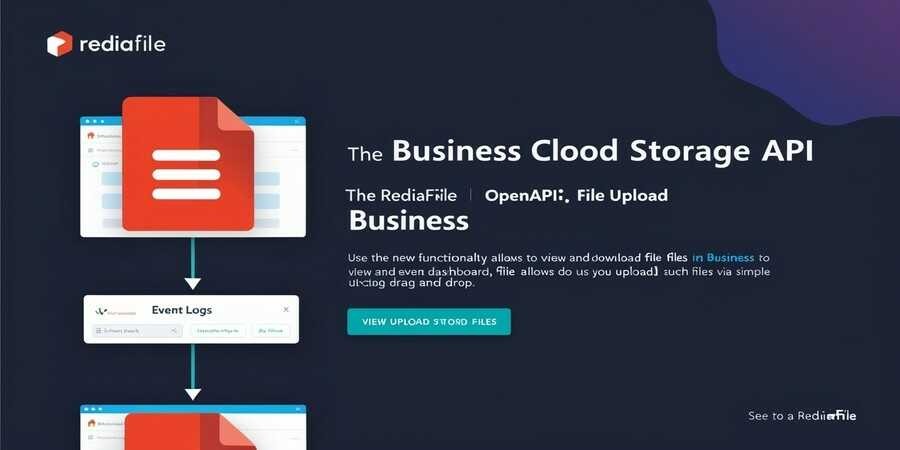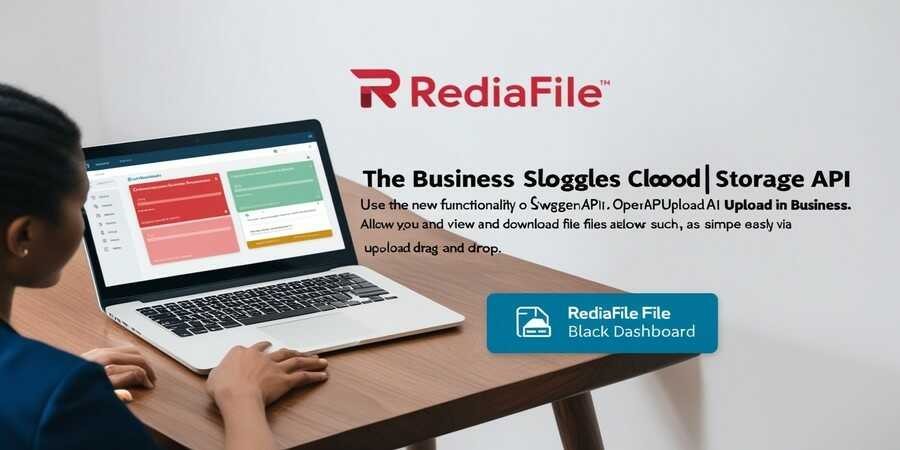

Business Cloud Storage: Mastering OpenAPI File Upload and Event Log Integration
You juggle files across teams every day. Data gets stuck in silos. Uploads take too long. Security worries keep you up at night. Traditional file management holds businesses back. Rediafile Business Cloud Storage changes that. It offers a simple way to handle files in the cloud. This tool fits right into your operations. It keeps everything safe and easy to access.
Rediafile shines with its OpenAPI setup. You can automate file uploads without hassle. Think about event logs. These hold key details on system events. The API lets you upload them fast. You view and download files just as quick. No more manual work. This setup turns storage into a smart part of your business. Let's explore how it works.
Section 1: Understanding the Rediafile Ecosystem and OpenAPI Foundation
The Core Architecture of Rediafile Business Storage
Rediafile builds on strong security layers. It uses encryption for all data at rest and in transit. You get peace of mind with features like two-factor authentication. Scalability means it grows with your needs. Start small, then add users or storage without downtime.
Compliance matters for businesses. Rediafile meets standards like GDPR and HIPAA. This helps if you work in finance or health care. Tiered storage options let you pick what's best. Keep hot data close for quick access. Move cold data to cheaper spots for long-term holds.
The system runs on a global network. Files sync across locations. Teams in different offices grab what they need. No delays. This architecture supports heavy loads. Your business stays smooth even during peaks.
The Power of OpenAPI for Enterprise Integration
OpenAPI acts as a clear guide for APIs. In Rediafile, it uses Swagger specs to define endpoints. Developers read it like a map. No guesswork. You build integrations that work across tools.
This standard boosts documentation. Every endpoint has details on inputs and outputs. Teams share code easier. It connects with ERP or CRM systems. Send files from sales data right into storage. Pull logs for analysis.
Interoperability cuts errors. Your apps talk to Rediafile without custom fixes. Start with validation tools. Use Swagger Editor to check your spec. Catch issues early. This saves time on fixes later.
Key Use Cases: Beyond Standard Document Sharing
Automated data flows drive value in Rediafile. Businesses need quick backups. Event logs track user actions or errors. Upload them via API to spot issues fast.
Audit trails demand real-time capture. In retail, sync inventory logs to cloud. Avoid stock mix-ups. Backup sync keeps data safe from losses. One firm cut recovery time by half with auto-uploads.
Think compliance reports. Auto-send access logs to storage. Regulators check them easy. These cases show Rediafile as more than a file drop. It powers smart decisions.
Section 2: Implementing Secure File Uploads via the Rediafile API
Authentication and Authorization Protocols
Start with API keys. Generate one in your Rediafile dashboard. It ties actions to your account. For teams, use OAuth 2.0. Users grant access without sharing secrets.
Tokens refresh on their own. Set short lives for safety. Least-privilege rules limit what each key does. Viewers get read-only. Uploaders handle files only.
Test auth first. Send a simple GET request. If it works, move on. This step blocks unauthorized access. Your data stays locked down.
Step-by-Step: Programmatic File Upload Functionality
Begin with the upload endpoint. Use POST to /files/upload. Set content type to multipart/form-data. Attach your file in the body.
For big files, chunk them. Rediafile supports parts up to 100MB each. Send one, get a session ID. Resume if drops happen. Code it in Python or Node.js.
Handle errors smart. Set timeouts at 30 seconds. Retry on 5xx codes, up to three times. Log failures for review. This keeps uploads reliable.
- Prep the request with auth header.
- Add file and params like name.
- Send and check response code 201.
- Get the file ID for later use.
Managing Metadata and Version Control During Upload
Add metadata in the request body. Include tags like "event-log-2023" or owner details. This helps searches later. API params let you set custom fields.
Version control tracks changes. Upload a new file? It creates a version. Keep old ones for history. Roll back if needed.
Business context matters. Tag logs with timestamps or sources. Retrieve them by filter. This builds a clear trail. Your files gain smarts over time.
Section 3: Automated Event Log Viewing and Downloading
Accessing the Event Log Repository through the API
Hit the /logs endpoint to list files. Use GET with query params. Filter by date, like from=2023-01-01&to=2023-12-31. Add source=app-server for specifics.
Endpoints include /logs/{id} for single views. Paginate results with limit=50&offset=0. This handles large sets without overload.
Auth checks every call. Only approved users see logs. Set up webhooks for new entries. Get alerts on fresh data.
Efficiently Viewing and Parsing Log Data
Logs can grow huge. Rediafile offers streaming. Pull data in chunks without full download. View in your app or browser.
For parsing, use API filters. Extract errors or warnings. Batch process offline if needed. Tools like jq help sort JSON logs.
In finance, quick log access spots fraud. One bank views trades in seconds. Health care needs it for patient records. This feature meets tight rules. No delays in checks.
Direct view saves steps. Download only for deep dives. Balance speed with needs.
Optimizing Download Performance and Data Integrity
Use resumable downloads for big files. Start at byte 1000 if paused. Pre-signed URLs give temp links. Share without auth exposure.
Performance tips: Compress logs before send. Rediafile handles gzip. Checksums like MD5 verify on arrival. Match sent and received.
If mismatch, redownload. Set headers for range requests. This ensures every bit lands right. Your data stays true.
Section 4: Integration Strategies for Enterprise Systems
Integrating with CI/CD Pipelines for Deployment Artifacts
Dev teams love auto-uploads. After build, script pushes artifacts to Rediafile. Use Jenkins or GitHub Actions. Call the API in post-build steps.
Upload test reports or binaries. Store them tagged by version. Pull back for deploys. This cuts manual moves.
One software company sped releases by 40%. Artifacts wait ready in cloud. No local clutter.
Connecting Operational Dashboards (BI Tools)
Feed logs to tools like Tableau. API pulls data on schedule. Structure it as CSV or JSON.
Real-time monitoring shines. Watch server health via dashboard. New logs trigger pulls.
Use webhooks from Rediafile. They notify on uploads. Refresh views auto. Keep insights current. Suggest cron jobs for steady syncs.
Ensuring Compliance and Audit Trails with Automated Reporting
Auto-upload security scans. Meet regs like SOX without hands-on work. Logs build full trails.
User access reports go up daily. Review them for odd patterns. API handles batches easy.
This setup proves diligence. Auditors see clean records. Cut compliance costs by half for some firms.
Conclusion: The Future of Automated Business File Integration
Rediafile Business Cloud Storage brings speed to file tasks. Security wraps every step. Automation frees your team for big work.
OpenAPI file upload simplifies event log handling. View, upload, and download with ease. This turns storage into a live tool. Not just a shelf.
Key points stick: Strong auth keeps data safe. Chunked uploads manage sizes. Integrations boost workflows. Start with API docs today. Test a simple upload. Watch your operations improve. Sign up for Rediafile now and build that first integration.
Popular articles

Dec 02, 2024 12:41 PM

Dec 27, 2024 04:42 PM

Nov 25, 2024 08:02 PM

Dec 03, 2024 11:08 AM

Nov 25, 2024 08:21 PM
Categories
Comments (0)